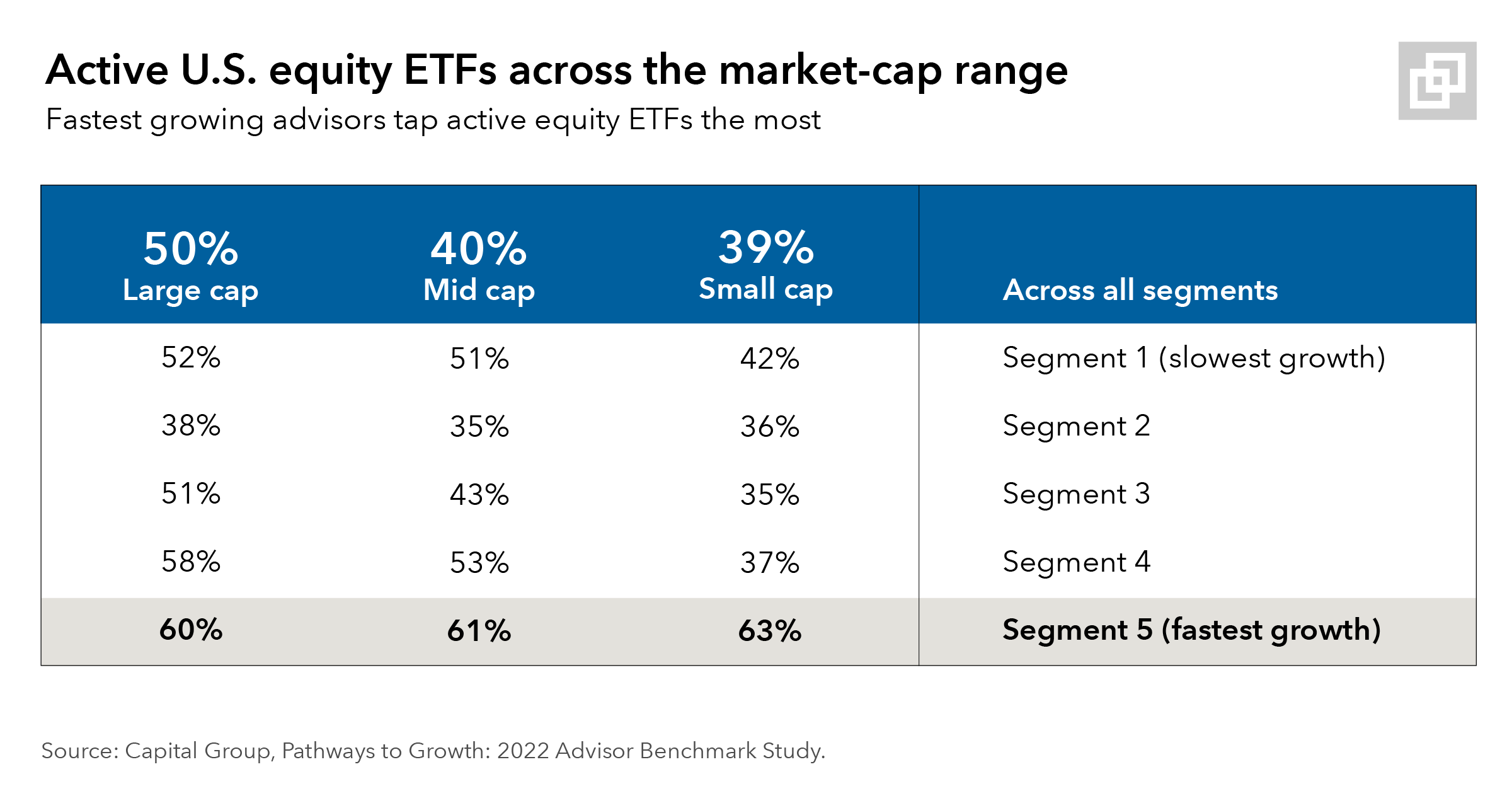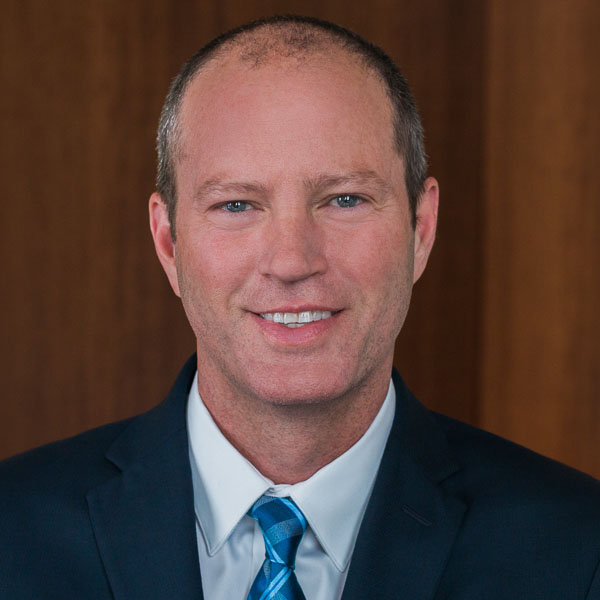Interest Rates
ETF
Capital Group’s Pathways to Growth: 2022 Advisor Benchmark Study surveyed more than 2,300 advisors to find out some key drivers of growth for advisory practices. Data gathered for the study indicated that the fastest growing advisors are using actively managed exchange-traded funds (ETFs) in client portfolios. The results suggest that for leading-edge advisors and registered investment advisor (RIA) firms, active ETFs have a strong role to play in client portfolios in concert with mutual funds, separately managed accounts (SMAs) and other investment vehicles.
We examine how the fastest-growing advisor practices are using active ETFs, from accessing nontraditional investment opportunities to core portfolio building blocks. We also explore why the adoption of active ETFs may still be in the early phases.
- The fastest growing advisor practices use more active exchange-traded-funds (ETFs) in client portfolios than do slower-growth advisors.
- Advisors with the highest asset growth are using active ETFs for U.S. equities across the market-cap spectrum as core holdings.
- Active ETF market share is still relatively small compared to passive, but market trends point to continued growth for actively managed ETFs.
Capital Group’s Pathways to Growth: 2022 Advisor Benchmark Study surveyed more than 2,300 advisors to find out some key drivers of growth for advisory practices. Data gathered for the study indicated that the fastest growing advisors are using actively managed ETFs in client portfolios. Advisors with practices attracting assets at the fastest clip also tap active ETFs for client exposure to U.S. equities, which shows they are comfortable using ETFs in core portfolios.
We examine how the fastest-growing advisor practices are using active ETFs, from accessing nontraditional investment opportunities to core portfolio building blocks. We also explore why the adoption of active ETFs may still be in the early phases.
Leading advisors by asset growth are more likely to use active ETFs than their slower-growth counterparts
Advisors who use ETFs still hold a higher allocation in passive ETFs across their portfolios. But the results from the study suggest that for leading-edge advisors and RIA firms, active ETFs have a meaningful role to play in client portfolios in concert with mutual funds, SMAs and other investment vehicles.
At least 60% of the fastest growing advisors feel it is important to use actively managed ETFs across the market-cap spectrum.
Top-growth advisors are the ones most likely to employ active ETFs

Source: Capital Group, Pathways to Growth: 2022 Advisor Benchmark Study. Data represent an aggregation of advisors who responded to the question, "Among the ETFs you currently use, roughly what proportion of assets are actively vs. passively managed?”
After surveying over 2,300 financial professionals, Capital Group also found that advisors increasing assets the most are using active equity ETFs in ways that may be surprising.
At least 60% of the fastest growing advisors feel it is important to use actively managed ETFs across the market-cap spectrum.1

Source: Capital Group, Pathways to Growth: 2022 Advisor Benchmark Study. Data represent an aggregation of advisors who responded with Extremely Important or Very Important to the prompt, "Please indicate how important actively managed ETFs are to your investment strategy for the following types of equity exposure: Large Cap, Mid Cap and Small Cap.”
One particularly interesting result from the survey is that among advisors experiencing the highest asset growth, 73% say actively managed ETFs are important for investing in U.S. equities, compared with 48% for international stocks.2 The common perception is that many advisors opt for passive in the U.S. and active in international markets. Our data, however, show that many advisors use active ETFs for U.S. stocks, which is helping to drive growth in active core ETFs for the center of client portfolios.
Among advisors experiencing the highest asset growth, 73% say actively managed ETFs are important for investing in U.S. equities.
“High-growth advisors are more active in everything they do. They’re proactive in seeking different ways to be better and build their practices,” said Mike Van Wyk, head of customer research and insights at Capital Group.
“Active ETFs are relatively new, so it makes sense that advisors with the highest asset growth rates are ahead of the curve on how to evaluate and use them in client portfolios, including as core building blocks,” Van Wyk added. “It shows that the fastest growing advisors have already settled on the role that active ETFs can play in client portfolios.”
Active ETFs punching above their weight
There is another reason why the high advisor usage of active ETFs for U.S. equities may be surprising: Some of the largest and oldest ETFs are passive funds that track traditional indexes like the S&P 500 Index. As the ETF marketplace continues to evolve, however, investors and advisors have many strategies to choose from than just passive ETFs for U.S. large-cap stocks.
Looking at the global ETF market, assets in active ETFs climbed to a record $474 billion as of July 2022.3 Passive ETFs still hold the vast majority of overall assets at $9.74 trillion globally,4 but there are signs that active ETFs are starting to catch up as more well-known asset managers create ETFs based on their active strategies. In particular, the “ETF Rule” adopted by the Securities and Exchange Commission in 2019 lets all ETFs employ “custom baskets” for creation and redemption of shares, making it easier to introduce and manage active ETFs.5
The question of whether to use ETFs, mutual funds or SMAs depends on an investor’s specific objectives and situation.
Capital Group and other asset managers are making their well-known active investing approaches available in the transparent, tax-efficient and relatively low-cost ETF structure. This gives investors and advisors more choice in how they access active strategies by vehicle. It appears there may be pent-up demand from advisors for these active ETFs due to twin tailwinds: a preference for the ETF vehicle and advisors opting for active strategies in a volatile market. The question of whether to use ETFs, mutual funds or SMAs depends on an investor’s specific objectives, tax situation and type of account (retirement or nonretirement) they’re utilizing.
Yet, from a high level, there is plenty of evidence that active ETFs are a welcome addition to the fastest growing advisors’ toolkits.
1 Capital Group, Pathways to Growth: 2022 Advisor Benchmark Study. Data represent an aggregation of advisors who responded with Extremely Important or Very Important to the prompt, "Please indicate how important actively managed ETFs are to your investment strategy for the following types of equity exposure: Large Cap, Mid Cap and Small Cap."
2Capital Group, Pathways to Growth: 2022 Advisor Benchmark Study. Data represent an aggregation of advisors who responded with Extremely Important or Very Important to the prompt, "Please indicate how important actively managed ETFs are to your investment strategy for the following asset classes: Domestic Equity and International Equity."
3 “ETFGI reports assets invested in Active ETFs listed globally reached a record US$474 billion at the end of July 2022.” ETFGI.com, August 24, 2022.
4 “Active ETF Assets Hit a Record.” WSJ.com, August 24, 2022.
5 “ETF Custom Baskets A Game Changer.” ETF.com, July 23, 2021.
To read the full article, become an RIA Insider. You'll also gain complimentary access to news, insights, tools and more.
Already an Insider?
 Mike Van Wyk
Mike Van Wyk